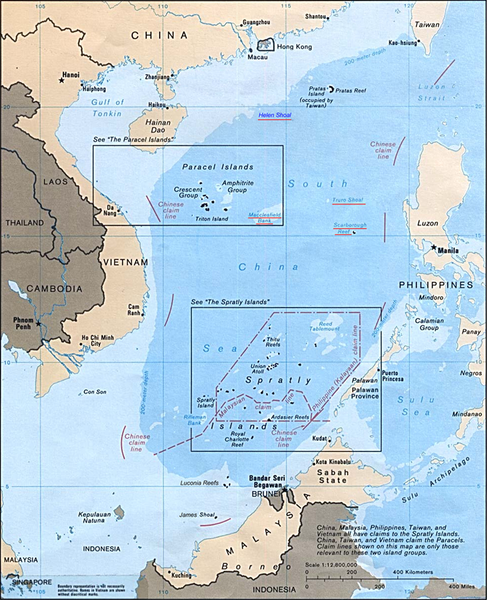Introduction
The territorial disputes between countries that share maritime borders have been in existence for the past several years. This problem saw the emergence of a wing within the United Nations specifically concerned about addressing the maritime disputes. According to Song (28), the United Nations Convention on Law of the Sea (UNCLOS) was enacted to address these territorial disputes that threatened world peace. One of the major territorial disputes that are yet to be resolved is the conflict in South China Sea. The maritime conflict in the South China Sea has existed for over the decades, and the attempts by the international community to address the issue has bore little fruits. In this paper, the researcher will conduct an analysis of this dispute, and the legal positions of the countries that lay claim to it as per the UNCLOS.
History and Course of the Dispute
According to Kivimaki (52), the dispute in the South China Sea is caused by both the territorial and maritime claims in this sea. The conflict can be traced to as far as the 3rd century where the region sparked numerous naval wars among the then existing world powers. During these early times, the problem that existed was the fight for the fishing ground. The Chinese fishermen found this region to be strategic both for fishing and international trade. The desire to have full control of this marital territory that brought conflict between China and the other world powers that found these waters attractive for trade. The Sino-French War of the 1884/1885 was as a result of the China’s move to control these waters against the wish of France.
In 1883, the German forces made a survey in South China Sea for reasons that were not very clear to China. China protested against this move. China feared the military capacity of German, and therefore, it did not engage. However, it could not hold back when France came to lay claim in the region a year later. According to Kivimaki (36), it was the British government that launched a modern claim in the Spartlys Islands for the first time, in 1887. In the same year, France and China, then known as the Qing Empire, entered an agreement to set clear maritime boundaries between Vietnam and China. In this agreement, China was largely considered the winner because it gained massive control over the South China Sea.
In 1898, the United States took over the ownership of the Philippines Island that was till then, controlled by Spain. This was after the Spanish-American War that saw the United States forces defeat the Spanish forces. The period from 1902 to 1931 saw major conflicts among various nations as they struggled to gain control of this region. These nations included France, China- having changed its name from Qing Dynasty in 1911, and Japan. Japan was an emerging power and its forces were able to drive the Chinese forces from this strategic maritime region with ease. However, tides turned against Japan following the World War II. The defeat of the Axis Alliance, which Japan was an active member, saw Japan forced out of this strategic territory in favor of China.
In the recent times, the dispute has seen the number of nations contesting the ownership of this marital region increase. The countries sharing this maritime border with China, through their alliance called ASEAN, have laid claim on this territorial waters, especially since 2002. The alliance is largely seen as an attempt to unite against a common aggressive foe which in this case is China (Kivimaki 86). The figure below shows the contested territorial waters in South China Sea.

The Cause of Dispute
According to Amer and Schofield (54), scholars who have paid attention to this conflict contend that the main reason why the ownership of this region has been contested by various nations, including the United States and European nations, is its rich natural resources and its strategic location in terms of international trade. Then Indian government has made passionate plea to all the nations involved that the dispute should be resolved and the territory opened for trade because most of its international business operations rely on it. China, the ASEAN, and Japan have been exploring oil in this region. The United States of America has been actively conducting military drills in the same region. According to the principles of the United Nations Convention on the Law of the Sea, almost all the countries laying claim to this region, with exemption of the United States and European Countries, have a right to this territorial waters because of they all border this sea. That is the legal position held by all the parties involved.
done in as little as 1 hour
Conclusion
The maritime dispute in South China Sea is one of the longest territorial disputes that involve many countries. The presence of oil deposits in the region and other natural resources, coupled with its strategic location in terms of trade and military operations, have seen it become largely contested by these nations. A lasting solution over the disputes is yet to be found.
Works Cited
Amer, Ramses, and Cliv e Schofield. The Sino-Vietnamese Approach to Managing Boundary Disputes. Durham: IBRU, 2002. Print.
Huang, Jing, and Andrew Billo. Territorial Disputes in the South China Sea: Navigating Rough Waters. New York: Cengage, 2015. Print.
Kivimaki, Timo. War or Peace in the South China Sea. Copenhagen: Nordic Institute of Asian Studies, 2002. Print.
according to your instructions
Song, Yann-huei. Managing Potential Conflicts in the South China Sea: Taiwan’s Perspective. Singapore: World Scientific, 2009. Print.
